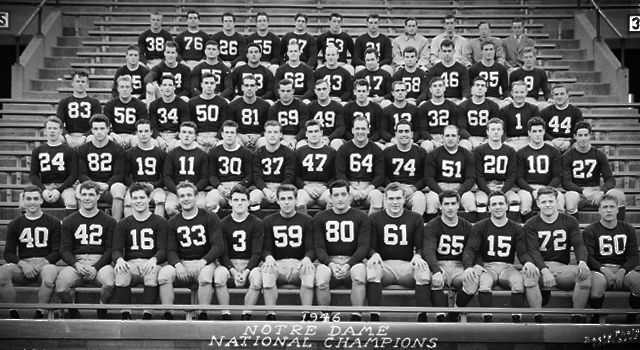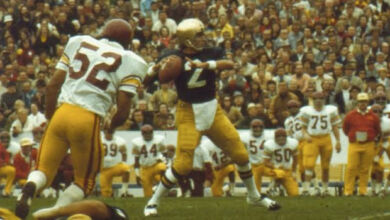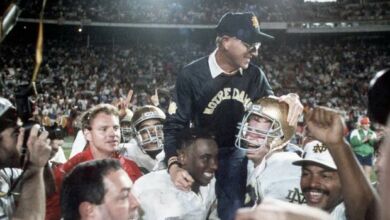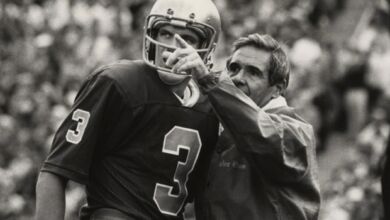
1946 was morning in America. After making Japanese rubble bounce with a Fat Man and a Little Boy, victory was assured. Japan had followed Italy and Germany to defeat.
Frank Leahy was, after having been promoted to Lieutenant in the Navy, a civilian, and back behind his desk as Head Coach of Notre Dame. Mckeever and Devore had gone a “respectable” 15-4-1 while Leahy was in the Navy. Frank Leahy was interested in a destination well North of “respectable.”
The Greatest Recruiting Class of All-Time
Lou Holtz talked about one of his coaching visits to play in Annapolis against Navy at Navy-Marine Corps Memorial Stadium. On the rim of the stadium interior are listed the names of great Naval battles: Guadalcanal, Midway, Iwo Jima and many others. Lou used to kid “I looked up at that and said, ‘boy, they played quite a schedule.'”
| 1946 Notre Dame Schedule | ||
| Date | Opponent | Result |
| 9/28/46 | @ Illinois | W, 26-6 |
| 10/5/46 | vs. Pittsburgh | W, 33-0 |
| 10/12/46 | vs. Purdue | W, 49-6 |
| 10/26/46 | @ #17 Iowa | W, 41-6 |
| 11/02/46 | vs. Navy | W, 28-0 |
| 11/08/46 | vs. #1 Army* | T, 0-0 |
| 11/16/46 | vs. Northwestern | W, 27-0 |
| 11/23/46 | @ Tulane | W, 41-0 |
| 11/30/46 | vs. #16 USC | W, 26-6 |
| * Played at Yankee Stadium | ||
Well, while in the Navy, Leahy was recruiting players who had, in fact “played” in venues just like that and many more. Being shot at in combat tends to shift one’s balance between adversity and success and tends to “sharpen focus.”
The cupboard in South Bend was far from bare, but when Leahy brought the troops back home, it was magnificent. Terry Brennan, Bill Fischer, John Mastrangelo and Bill Walsh all returned from the prior year, and Leahy had not forgotten to bring in some great freshmen. Leon Hart, from Turtle Creek, Pennsylvania, was one of them.
Jim Martin and Emil “Red” Sitko had postponed their arrival at Notre Dame until they came back from the Navy. They were just a few of the very mature frosh who were vets, older, bigger, stronger, wiser. Lujack, Czarobski, Jack Zilly and Jim Mello, who had already lettered at ND, were returning veterans.
Martin, Sitko, Hart, Czarobski and Lujack would all wind up in the College Football Hall of Fame.
In football’s descriptive hyperbole, players are often referred to as “battle-tested.” Most often it is an innocuous metaphor; in Notre Dame’s case in 1946 it was a precise description.
1946 Notre Dame Spring and Fall Practice
Leahy was not bashful about having tough practices and pitting players against each other for playing time. Leahy had just suffered a two year withdrawal from Fighting Irish football, and he wasted no time “re acclimating.” The result was a skilled, sound, and deep team.
When the frosh arrived, they had to compete with older tougher, more mature players. Pressure, indeed, was in the process of making diamonds.
Early Season Domination
The Irish opened the season in Champaign-Urbana and smashed the Fighting Illini 26-6. The Illini were a sound squad and would win the Big Ten Championship and then hammer UCLA 45-14 in the Rose Bowl. But the Irish easily swatted them aside. The Irish then returned home to shutout Pittsburgh 33-0. Lujack was now a mature quarterback. Terry Brennan, Emil Sitko, Jim Mello and Coy McGee led the backfield, but it was the merciless Irish depth that ran over opponents. The Irish rushed for OVER 3,000 yards, Sitko was the rushing leader with a mere 346 yards. But a total of 7 players rushed for over 200 yards, a total of 13 for over 100 yards. In the background can you hear “When Irish backs go marching by?”
The next visitor was Purdue, and they fell by a compliant 49-6.
Well, could the Irish perform well on the road? They traveled next to Iowa City and routed the Hawkeyes 41-6.
The distant drumbeat was the sound of November 9th’s game against mighty Army, but there was one more game to play, against Navy in Baltimore. The Irish notched their second shutout 28-0. Leahy had said “Prayers work better when the players are big.” And with studs like Leon Hart, Ziggy Czarobski, Bill Fischer, George Connor, and Jim Martin in his trenches, he could back it up.
Notre Dame vs. Army: “The Game of the Century’
Notre Dame versus Army, November 9, 1946, Yankee Stadium. Earl “Red” Blaik had led the cadets to the ’44 and ’45 national championships and the Cadets were riding a record 25 game winning streak. And it was no accident. Mr. Inside, Doc Blanchard had won the Heisman Trophy in 1945. Mr. Outside, Glenn Davis, was on track to win it in 1946. Hank Foldberg was an All-America caliber end and quarterback Arnold Tucker was the primary competitor for Lujack’s pursuit of All-America quarterback awards.
The Cadet ranks were swelled as young Americans wanted to join the long Gray line and become the next Patton, Eisenhower, Bradley or MacArthur.
The New York press, which then set the tone for the press coverage across America’s 48 states, was frothing at the mouth. War heroes on both teams? Blaik and Leahy? They had witnessed the Four Horsemen, the Gipper game, the exploits of Blanchard and Davis, and now were contemplating a contest on the field made sacred by Ruth, Gehrig and Dimaggio. The newspaper pregame build-up cup ran over with enthusiasm and anticipation. There was one event in America that day. With the war over, it was permissible to exhale and focus on a big football game. And every American knew it. Notre Dame-Army.
The sky was a somber, focused gray in the Bronx, and defenses dominated. It was trench warfare, institutionally familiar to the Army and experientially familiar to ND’s vets. Yards were precious. Yet the Irish marched to the Cadet four yard line in the second quarter. The subway alumni, out in force, roared with anticipation, but that long Gray line would not break and Army held on downs. Later, Doc Blanchard broke clear but was taken down by a nifty open field tackle by Lujack.
Thrilling and tense as it was, the game ended in a noble 0-0 tie.
It is the only time in college football history that four (eventual) Heisman Trophy winners played on the same field. Army’s Blanchard and Davis and Notre Dame’s Lujack and Hart.
Army held its #1 ranking after the game, but in the final three games against Northwestern, Tulane and Southern Cal, Notre Dame showed its might by a combined 94-6 total.
The Irish were the nation’s leaders in:
- Total offense 441.3
- Rushing offense 340.1
- Total defense 141.7 yards
- Scoring defense 2.7 points
The writers acknowledged Notre Dame’s overall dominance and the Associated Press voted the Irish the #1 team.
Glenn Davis won the Heisman trophy, and he, Lujack, George Connor and Doc Blanchard were unanimous All-Americans.
Frank Leahy had his second national championship. And his team was both young and old. Old in their years on the calendar and in maturity. But because of their service years, many were just beginning their football eligibility.
Having been rescued by the Navy during the war, Notre Dame could now stand on its own. A college it may have been, but a dream to millions, an obsession to those who loved it.
Go Irish!




My father was Bill Walsh and played center for this team from 1945 to 1949. I am his daughter. My dad passed away 6 years ago but my mom is still alive and well. She has lost a radio interview done with my dad as a guest taped at a reunion of this football team. Any ideas on how I could locate a copy of that interview. I think it took place in 1996. Possibly a 50 year reunion. Any suggestions would be greatly appreciated! My dad had a long and great career in the AFL and the NFL as both a player and a coach. He had a framed pictured of that teams reunion right next to his chair. He said being there was one of the greatest things in his life. He loved Notre Dame.
I’m an antique collector, and came across the 1946 National championship game ball, the lady who sold it said it was given to her father who was some official at the game. She said it was the ball that was said to have been recorded, and the caption said, ” the kick heard around the world. What do I do with such a rare game ball, which has som signatures on it. It came with a 1946-’47 all stars signed game ball as well. let me know what to do, Cheers, Peter.
That is interesting you came across the ball. My grandfather played in this game and on the team during this time (#17). I remember hearing all the stories when I would visit my grandfather and family over the summers.
I have the team picture with many of the players autographs on the back. My mother worked there and kept it til she died in 2005. Now I know why it was so special to her. Thanks for the insight into a long held memory.
A Special year, 1946. In so many ways.
If you ever get a chance to watch these guys on film you’ll see why they were so dominate. The OL would put three or four DL players on the ground at the snap and go hunting LB’s. It was men against against boys.
In September 1946 I started into the second grade at Holy Names Catholic School. Our school had a pretty good grade school football team for 6, 7, and 8th grade. Our school song was the Notre Dame Fight Song.
I was the only Catholic kid in my neighborhood. Used to get teased about it. Football was always big, lots of Ole Miss fans. One thing about being Catholic we had the best football team in the country.
I used to pretend to be Johnny Lujack when playing sandlot.
Kyle – what’s up with the under age chinese love porn ads??? I would expect Ohio State to have this garbage on their site. I understand it is a tough economy…but really? G-strings & all?
Frank,
It’s not on here now. If it shows up again, I’ll be happy to snap a screen picture and send it in.
Sorry, I did not think fast enough to snap a screen shot at the time.
Frank,
I just snapped three shots on the side bar. I will send them to you.
It’s the extra insights that you add, that makes this so appealing to read.
Attaboy!
No squad managed more than 6 points against Notre Dame in 46! That is something.
ONLY 4 teams scored against that squad each limited to 6 points… total of 24 against & 271 for = 247 over 9 opponents
Avg = 27.4- 0… so yeah dominant
Beat the Big Ten Champ- Illinois 26- 6
Beat #16 USC 26- 6
beat #17 Iowa 41- 6
Tied #1 ARMY ALLOWING 0 POINTS against the consensus #1 team at that point in time as previously #4 Rankd ND
Ended up as TWO time Back to Back National Champions & sent over 40 players from these teams into the professional ranks